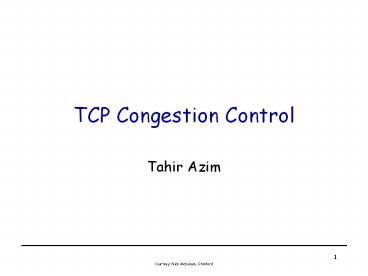TCP Congestion Control - PowerPoint PPT Presentation
1 / 18
Title:
TCP Congestion Control
Description:
TCP Congestion Control Tahir Azim Main points Congestion is inevitable Congestion happens at different scales from two individual packets colliding to too many ... – PowerPoint PPT presentation
Number of Views:120
Avg rating:3.0/5.0
Title: TCP Congestion Control
1
TCP Congestion Control
- Tahir Azim
2
Main points
- Congestion is inevitable
- Congestion happens at different scales from two
individual packets colliding to too many users - TCP Senders can detect congestion and reduce
their sending rate by reducing the window size - TCP modifies the rate according to Additive
Increase, Multiplicative Decrease (AIMD). - To probe and find the initial rate, TCP uses a
restart mechanism called slow start. - Routers slow down TCP senders by buffering
packets and thus increasing delay
3
Congestion
A1(t) 10Mb/s
H1
R1
D(t) 1.5Mb/s
H3
A2(t) 100Mb/s
H2
A1(t)
D(t)
X(t)
A2(t)
A2(t)
Cumulative bytes
A1(t)
X(t)
D(t)
t
4
Time Scales of Congestion
Too many users using a link during a peak hour
700
800
900
TCP flows filling up allavailable bandwidth
1s
2s
3s
Two packets collidingat a router
100µs
200µs
300µs
5
Dealing with CongestionExample two flows
arriving at a router
A1(t)
?
R1
A2(t)
Strategy
Drop one of the flows
Buffer one flow until the other has departed, then send it
Re-Schedule one of the two flows for a later time
Ask both flows to reduce their rates
6
Congestion is unavoidableArguably its good!
- We use packet switching because it makes
efficient use of the links. Therefore, buffers in
the routers are frequently occupied. - If buffers are always empty, delay is low, but
our usage of the network is low. - If buffers are always occupied, delay is high,
but we are using the network more efficiently. - So how much congestion is too much?
7
Load, delay and power
Typical behavior of queueing systems with random
arrivals
A simple metric of how well the network is
performing
Power
Average Packet delay
Load
Load
optimal load
8
Options for Congestion Control
- Implemented by host versus network
- Reservation-based, versus feedback-based
- Window-based versus rate-based.
9
TCP Congestion Control
- TCP implements host-based, feedback-based,
window-based congestion control. - TCP sources attempt to determine how much
capacity is available - TCP sends packets, then reacts to observable
events (loss).
10
TCP Congestion Control
- TCP maintains additional Congestion Window, cwnd
- TCP sources change the sending rate by modifying
the window size - Window minAdvertized window, Congestion
Window - In other words, send at the rate of the slowest
component network or receiver. - cwnd follows additive increase/multiplicative
decrease - Initialize cwnd with window size of 1 or 2
segments - On receipt of Ack for a full window Increment
cwnd by 1 segment - On packet loss (timeout) cwnd 0.5
Receiver
Transmitter (cwnd)
11
Additive Increase
Src
D
D
A
A
D
D
A
A
D
A
D
A
Dest
Actually, TCP uses bytes, not segments to
count When ACK is received for a full window
MSS lt cwnd, except at the start
12
Leads to the TCP sawtooth
Window
Timeouts
halved
Could take a long time to get started!
t
13
TCP Sending Rate
- What is the sending rate of TCP?
- Acknowledgement for sent packet is received after
one RTT - Amount of data sent until ACK is received is the
current window size W - Therefore sending rate is R W/RTT
- Is the TCP sending rate saw tooth shaped as well?
14
TCP and buffers
15
TCP and Buffers
- For TCP with a single flow over a network link
with enough buffers, RTT and W are proportional
to each other - Therefore the sending rate R W/RTT is constant
(and not a sawtooth) - But experiments and theory suggest that with many
flows - Where p is the drop probability.
- TCP rate can be controlled in two ways
- Buffering packets and increasing the RTT
- Dropping packets to decrease TCPs window size
16
Slow Start
Designed to find the fair-share rate quickly at
startup or if a connection has been halted (e.g.
window dropped to zero,or window full, but ACK
is lost). How it works increase cwnd by 1 for
each ACK received.
1
2
4
8
Src
D
D
D
A
A
D
D
D
D
A
A
A
A
A
Dest
17
Slow Start
Window
Timeouts
halved
Slow start in operation until it reaches half of
previous cwnd.
Exponential slow start
t
Why is it called slow-start? Because TCP
originally had no congestion control mechanism.
The source would just start by sending a whole
windows worth of data.
18
Congestion control in the Internet
- Maximum window sizes of most TCP implementations
by default are very small - Windows XP 12 packets
- Linux/Mac 40 packets
- Often the buffer of a link is larger than the
maximum window size of TCP - A typical DSL line has 200 packets worth of
buffer - For a TCP session, the maximum number of packets
outstanding is 40 - The buffer can never fill up
- The router will never drop a packet































